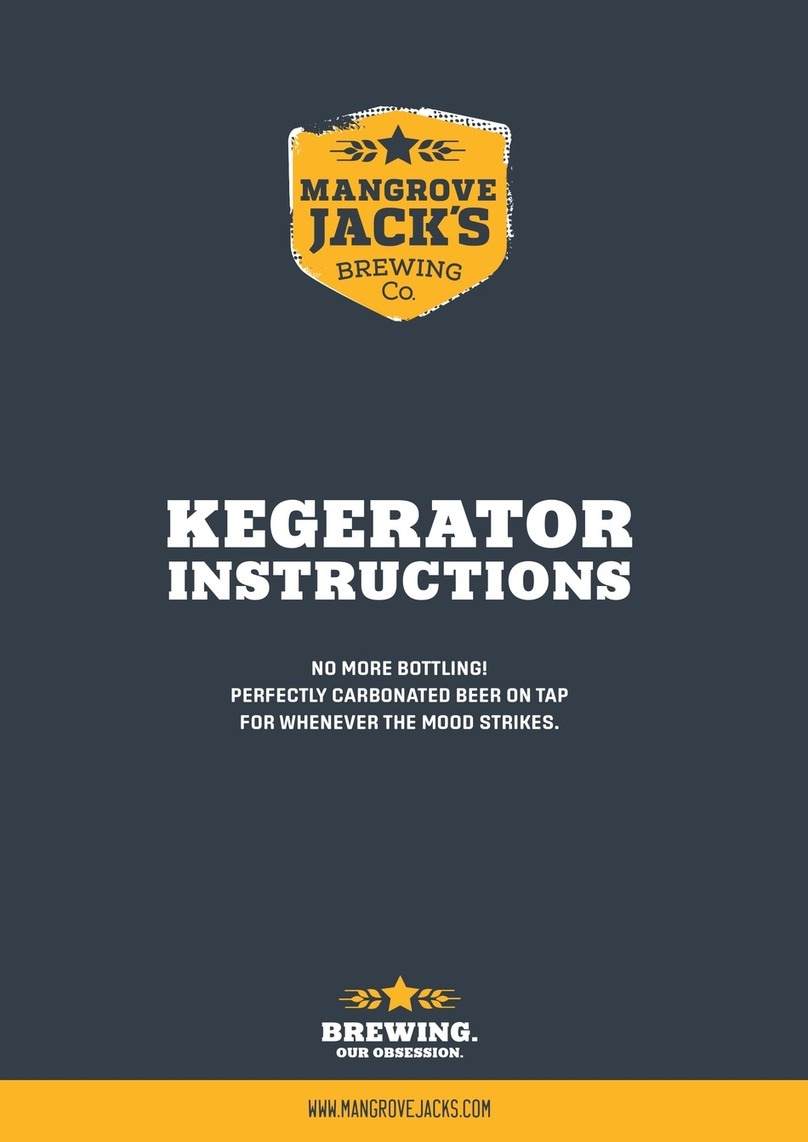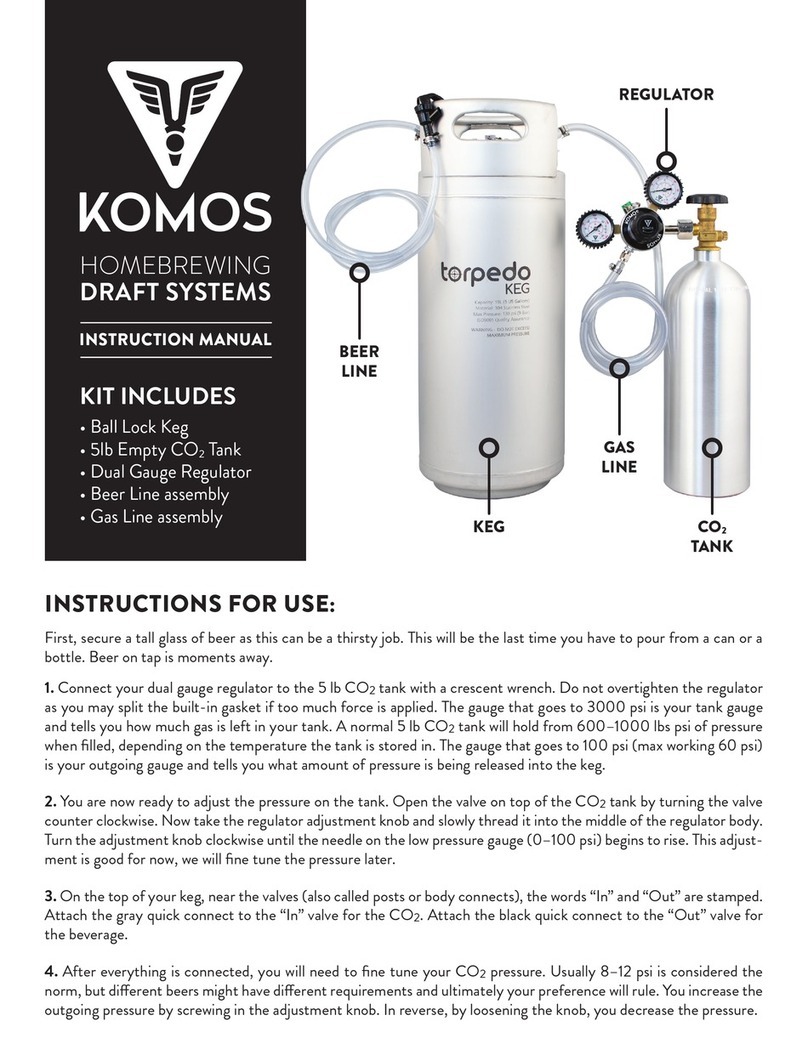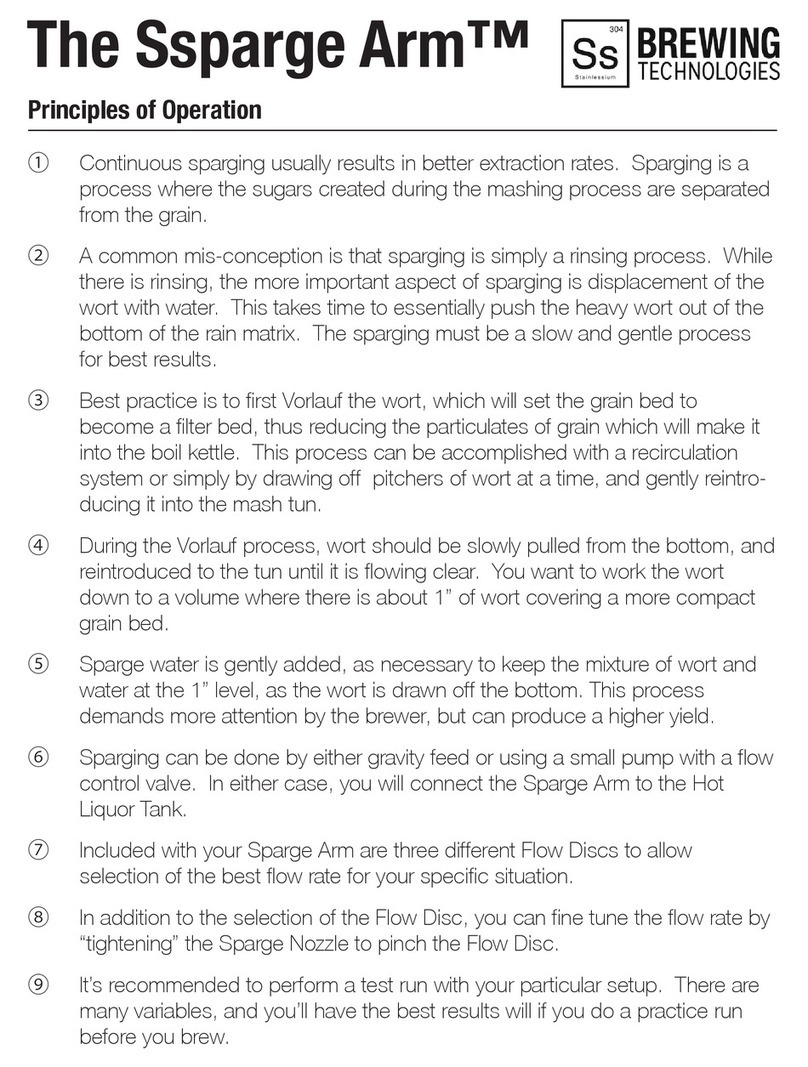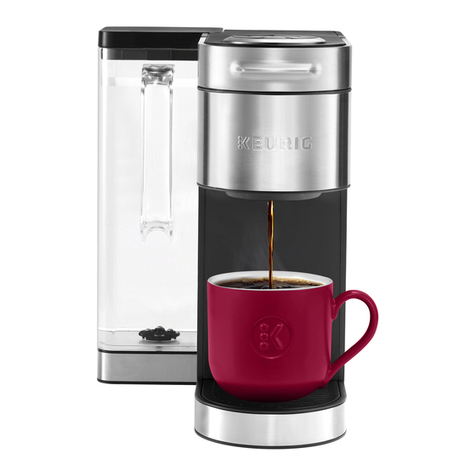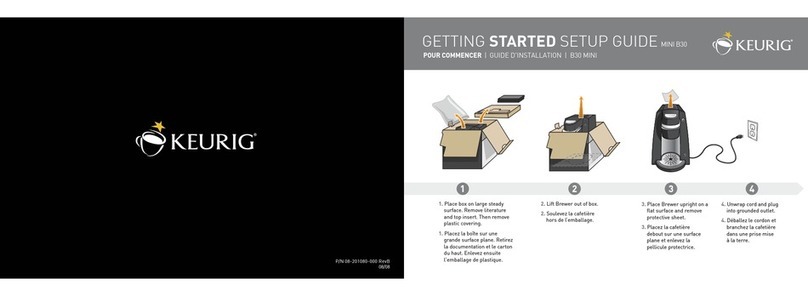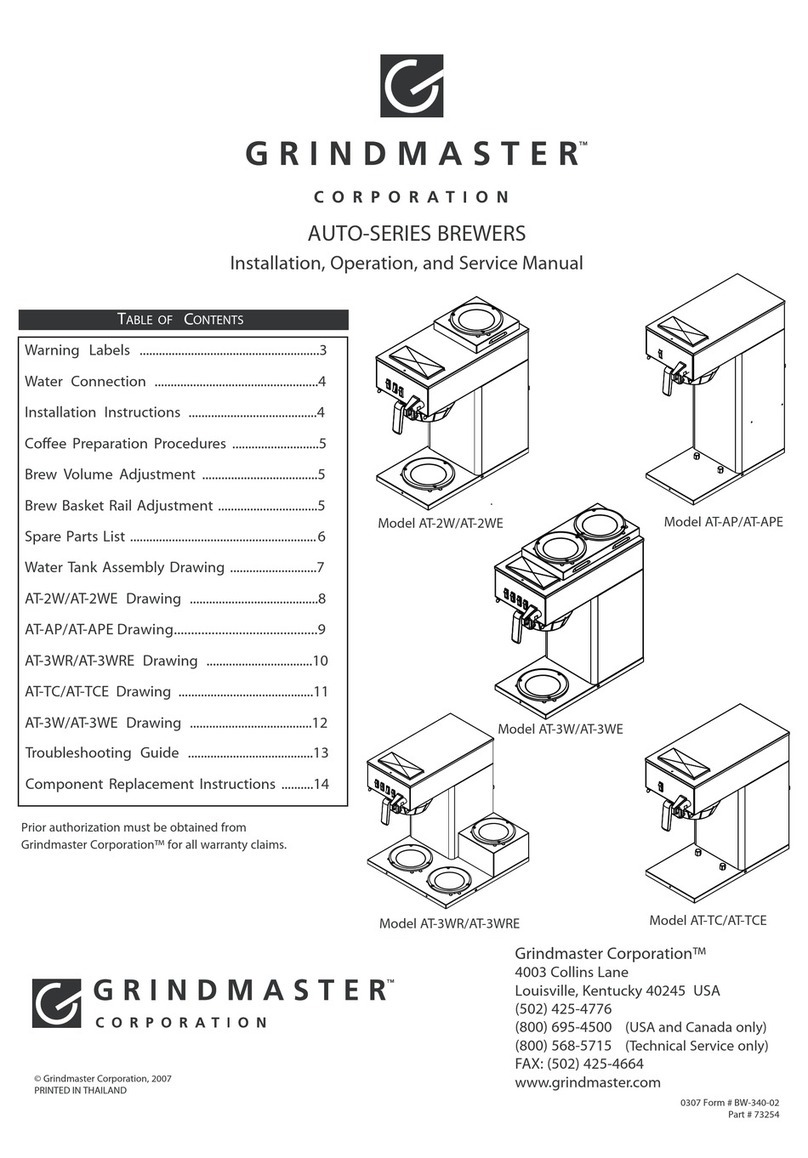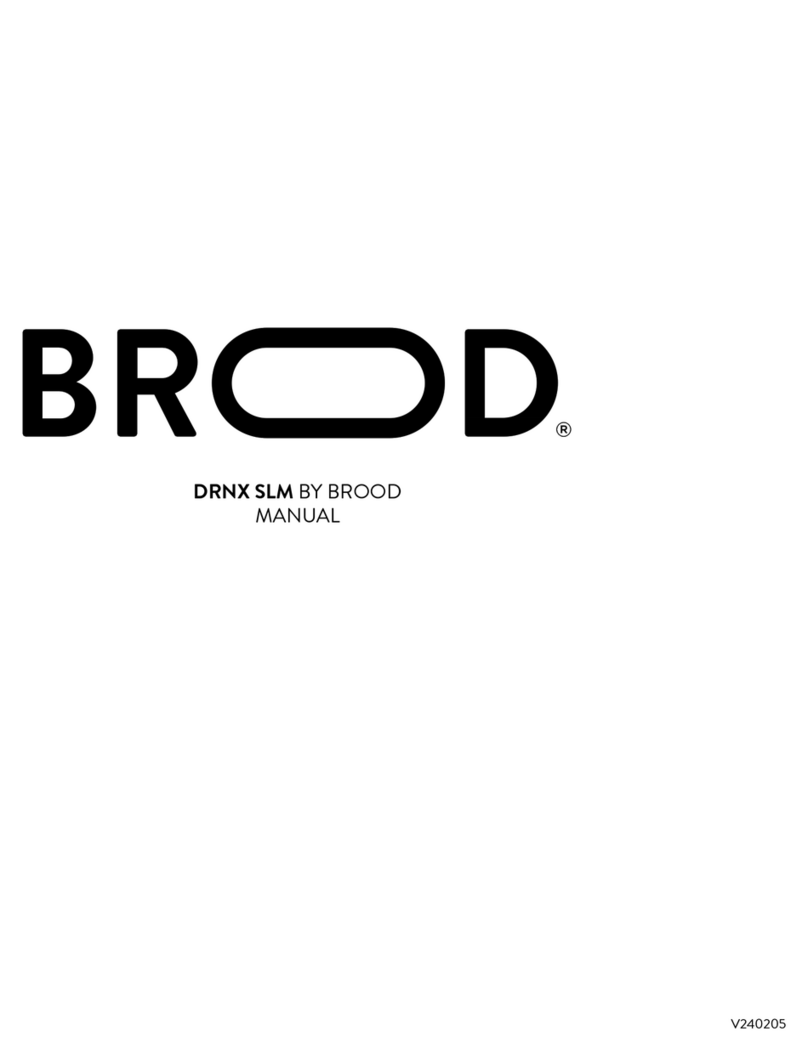Mangrove Jack's Kegerator Series User manual

NO MORE BOTTLING!
PERFECTLY CARBONATED BEER ON TAP
FOR WHENEVER THE MOOD STRIKES.
Cheers!
KEGERATOR
INSTRUCTIONS
BREWING.
OUR OBSESSION.

IMPORTANT SAFETY INSTRUCTIONS
This appliance is not intended for use by persons (including children) with reduced physical,
sensory or mental capabilities, or lack of experience and knowledge, unless they have been given
supervision or instruction concerning use of the appliance by a person responsible for their safety.
Children should be supervised to ensure that they do not play with the appliance. If the supply
cord is damaged, it must be replaced by the manufacturer, its service agent or similarly qualified
persons in order to avoid a hazard. This appliance is intended to be used in household and similar
applications such as: – sta kitchen areas in shops, oces and other working environments;
– farm houses and by clients in hotels, motels and other residential type environments;
– bed and breakfast type environments; – catering and similar non-retail applications.
•If pressurised aerosol containers bear the word “flammable” and/or a flame symbol, do not store them
inside the Kegerator. If you do so, you may cause an explosion.
INFORMATION ON DISPOSAL
• Most of the packing materials are recyclable. Please dispose of those materials through your
local recycling depot or by placing them in appropriate collection containers.
• If you wish to discard this product, please contact your local authority and ask for the correct
method of disposal.
• This appliance contains insulation formed with flammable blowing gases. Avoid safety hazards
by carefully disposing of this appliance.
• When you dispose of your old refrigerator, remove any doors. Children can suocate if they get
trapped inside.
WWW.MANGROVEJACKS.COM

1. Remove trays and parts from inside Kegerator.
2. If you want the Kegerator on wheels then fit the wheels.
3. Fit the top rails.
4. Fit the CO2cylinder holder if required.
5. Thread the pipes attached to the tower into the Kegerator.
6. Secure the tower.
7. Crimp the black liquid disconnects to these tubes.
8. Attach spare tubing to prong of the brass gas splitter. Thread
that tube from the inside of the Kegerator through the hole
cover (insert a hole through the centre of the hole cover to do
this) at top right hand corner.
9. Crimp the regulator to this tube.
10. Leave the Kegerator upright in its final place for 1 hour before
turning it on.
ASSEMBLY IN BRIEF
BREWING.
OUR OBSESSION.

1. PREPARATION
• Remove all trays from inside the Kegerator body.
• Read your CO2Cylinder Safety Instructions that are provided with your cylinder.
• Sit ends of your tubing that are not connected to anything in a jug of warm water to
make the ends more malleable and easier to fit on to attachments if you wish to.
• Remove any plastic protective layer on the stainless steel. This layer can become
hard to remove if the unit is operated with it on.
2. FITTING THE WHEELS
• If you would like to fit the wheels to your Kegerator - Turn the Kegerator onto its side.
NOTE: You may like to lay down some cardboard first if assembling on a hard surface.
• Remove the 4 adjustable feet on the base of the Kegerator.
• Screw on the wheels using the screws from the larger bag of 16 screws.
The 2 locking swivel castors should be installed in the front of the Kegerator for
easy access.
• Position Kegerator back upright.
NOTE: The Kegerator body should be left upright for at least 1 hour before turning it on. This
allows for the refrigerant gas to settle, in order to work properly.
3. FITTING THE RAILS TO THE TOP OF KEGERATOR
• Place the 2 metal rails on top of the Kegerator so the curved sides face
upwards and the screw holes line up.
• Empty the remaining packet of screws.
• Using the 4 small screws, screw in the rails to the top of the Kegerator.
4. ATTACHING THE CO2CYLINDER SUPPORT
• Attach the cylinder support rack onto the 4 studs located at the back of the Kegerator.
Align the holes in the cylinder support with the studs and push down firmly.
WWW.MANGROVEJACKS.COM

5. FITTING YOUR CO2CYLINDER
• Slide your fully charged CO2cylinder into the stand.
NOTE: You will need to have purchased this separately.
• If your cylinder is too big, you can have this sitting on the ground behind
the Kegerator and may not need to attach the cylinder support.
6. ATTACHING THE BEER TOWER TO THE KEGERATOR
• Remove hole cover on top of Kegerator.
• Place the rubber gasket around the hole in the top of the Kegerator. Line up the screw
holes.
• Feed the tubes that run through the Beer Tower through the centre hole in the
top of the Kegerator and sit the Beer Tower on top lining up the screw holes
with the rubber gasket and the Kegerator top screw holes.
• Use the remaining screws to screw on the Beer Tower. Be sure to screw it
in tightly.
NOTE: Lift the cover at the base of the Beer Tower to find the screw holes.
• Reattach the Beer Tower lid.
• Screw on the black tap handles.
7. ATTACHING THE LIQUID DISCONNECTS
• Feed a clamp over one of the 3 m pieces of tubing in the inside of the Kegerator.
• Attach that tubing to a black liquid disconnect.
• Use a crimping tool or pliers to seal the clamp where the tubing meets the black
liquid disconnect.
• Repeat for the second 3 m piece of tubing and black liquid disconnect.
• If you have a third tap, do this for a third piece of tubing too.
• Coil the excessive hose and tie o with cable ties or similar to keep your hoses tidy.
BREWING.
OUR OBSESSION.

8. CONNECTING THE CO2CYLINDER
• Check your CO2Cylinder Safety Instructions for position of any nozzles and taps
before starting this step.
• You have a spare piece of 1 m tubing. Attach this to a prong on the brass gas splitter.
Feed on a clamp and using a crimping tool or pliers, seal the clamp where the tubing
meets the prong.
• Remove the hole cover at the back of the Kegerator. Insert a hole through the centre
of the hole cover. Put the hole cover back on.
• Feed this tube of the gas splitter through the hole in the hole cover at the back of the
Kegerator from the inside to the outside.
• Feed on a clamp.
• Attach this tubing to the regulator prong with the red control valve.
• Use a crimping tool or pliers to seal the clamp where the tubing meets
the prong.
• Fit the regulator to your CO2cylinder making sure the white nylon washer is in place.
• NOTE: Use a wrench to ensure it is tight enough so that no gas escapes.
WWW.MANGROVEJACKS.COM
9. FITTING AND CONNECTING YOUR KEGS
• Attach a grey gas disconnect to the “IN” side of one of the Kegs.
NOTE: To attach and detach you should push centre of disconnects down with your
thumbs while pulling the bottom up with your fore-fingers.
• Attach a black liquid disconnect to the “OUT” side of the same Keg.
• Repeat for second Keg (and third keg if you have a third tap) with remaining disconnects.
• Place Kegs inside the Kegerator ensuring that the tubing sits at the back and is not tangled.
• Place Kegerator where it has at least 30 cm clearance on either side and from the back of
the unit to the wall, to allow proper ventilation.
• Place drip tray on top of the Kegerator, turn it on and your Kegerator
is set up.

BREWING.
OUR OBSESSION.
USING YOUR KEGERATOR
1. OPENING THE CO2CYLINDER MAIN VALVE:
• Before opening the main valve located on the top
of the CO2cylinder, make sure the secondary
shut o valve located on the lower stem pipe of
the regulator is in the o position.
NOTE: When the secondary valve (handle) is
positioned horizontally, the valve is closed.
When the secondary valve (handle) is positioned
vertically, the valve is open. To open the main CO2
valve, (slowly) turn the main counter clockwise
until fully open. You will notice needles on both
gauges start to climb.
2. ADJUSTING THE CO2REGULATOR:
There are 2 pressure gauges on the CO2regulator.
The upper gauge, #1, monitors “LOW” internal Keg
pressure and must be adjusted to the correct
operating pressure of 10-12PSI/lbs. The lower
gauge, #2, monitors “HIGH” (CO2cylinder) pressure
and is not adjustable. The high pressure gauge also
acts as a fuel gauge to let you know when the CO2
cylinder needs refilling.
IMPORTANT: The internal operating pressure of
the beer keg should be adjusted and maintained
between 10-12 PSI. To adjust the “LOW” pressure
gauge;
*With your hands, turn the regulator adjustment
knob clockwise (follow the arrow on the knob)
this will increase “LOW” pressure. Counter
clockwise rotation of the adjustment knob will
decrease “LOW” pressure.
*When the required operating pressure is attained,
retighten the adjustment knob.
You are now ready to serve cold beer.
3. ELECTRONIC CONTROLS
The electronic control panel allows for total cabinet
temperature control as well as well as the option
for displaying (current) and modifying (setting) the
cabinet temperature in either degrees Celsius or
Fahrenheit.
• When you first plug in your Kegerator the LED
will display the ‘live’ cabinet temperature in
Fahrenheit and the thermostat will often be
set to 0˚C (32˚F). The following paragraphs
will explain how to modify the settings to suit
your requirements.
4. ADJUSTING THE TEMPERATURE:
*Press the up or down buttons once and release
to enter the ‘SET’ Mode. The LED display
will begin to flash and show the previous
temperature setting signifying the temperature
is ready to be adjusted.
*Use the up and down buttons to increase or
decrease the temperature by 1˚C/˚F.
5. CHANGING THE TEMPERATURE ON
THE DISPLAY:
*Press the circular selector button to alternate
the display between Celsius and Fahrenheit.
The corresponding pilot light adjacent to the
selector will aluminate to signify which unit of
temperature has been selected for display.
NOTE: In the event of a power failure, any modified
settings are lost and default settings are restored
once power resumes. We recommend using a
surge protector for this Kegerator.
6. BEER TEMPERATURE
Correct consistent temperature is an important
factor to consider when storing and dispensing
draught beer. Therefore, please adhere to the
follow guidelines:
• Beer can freeze, so it is important to select and
maintain proper operation temperatures inside
the Kegerator body.
NOTE: Beer will start to freeze at -2˚C (28˚F).
• Optimum temperatures for serving cold beer
are 2-4˚C (35.5-39˚F) (depending on the style of
beer and personal tastes).
• Temperatures that are too cool or too warm may
cause flavour loss, o tastes and dispensing
problems.
• Periodically monitor your Kegerator (adjust as
necessary).
• Keep the Kegerator door closed as much as
possible to avoid temperature fluctuations.

1. REPLACING AN EMPTY CO2CYLINDER
• Close the main cylinder valve by turning in a
clockwise direction.
• Close the secondary shut-o valve by turning to
a horizontal (east/west) position on the lower
stem pipe.
• Remove the empty cylinder.
• Remove dust cap from new and/or replacement
CO2 cylinder.
• Reattach regulator assembly to new/
replacement cylinder (tighten with wrench).
• Slowly open main valve all the way.
• Readjust regulator pressure (if necessary)
between 10 – 12PSI/lbs.
• Open the secondary shut-o valve by turning to
a vertical (north/south) position on the lower
stem pipe.
2. FILLING YOUR KEG
• Take o your Keg lid by pulling back the lid
lever. Clean and sterilise your Keg.
SEE CLEANING AND MAINTENANCE.
NOTE: You can fill it with CO2before filling it with
beer to ensure that there is no oxygen in the Keg if
you wish. Make sure you release the pressure from
the Keg before opening.
• To fill your Keg with beer, use an auto syphon to
transfer beer from your fermenter to the Keg. Do
not allow the beer to splash in the Keg as this
will introduce oxygen into your beer and create
o flavours.
• When you have finished adding your beer, put the
lid back on and close it by pulling the lever down
and make sure the Keg is sealed properly.
3. CARBONATING YOUR BEER
Attach the grey gas disconnect to the “IN” post on
your Keg.
• You can leave the beer to carbonate at 10-12PSI
over a week to fully carbonate. If you want your
beer to be carbonated faster you should increase
the PSI up to around 25PSI.
• Then 3 times over a 24 hour period rock the Keg
vigorously for 60 seconds to allow the CO2to
dissolve into the beer.
• Then release the pressure in the Keg. Do this until
your beer is carbonated to your liking.
• Before checking the carbonation of your beer
release the pressure by pulling up on the pin
pressure release valve and turn the serving
pressure down below 12PSI.
• Repeat process if not carbonated to the right level.
The Keg is now tapped and ready to draw beer.
4. DISPENSING BEER
Use the following techniques to dispense beer with
approximately 2 cm of head.
• Rinse a ‘beer clean’ (rinsed with water) glass
under cold water.
• Place glass beneath tap, and tilt at a 45˚ angle.
Leaving approximately 0.5 cm between the glass
and the tap.
• Fully draw the dispenser handle and fill the glass
to 2/3 full.
• Level the glass and finish topping o by
continuing the pour in the centre of the glass.
• Make sure the handle is fully returned to its
previous ‘o’ position when the draw
is complete.
DO NOT:
• Begin the draw with the glass in an upright
position.
• Use frosted glassware, as the temperature
between the frozen glass and the beer in the keg
can cause a ‘wild’ draw (too much foam).
• Partially (or slowly) draw the dispenser handle,
this will lead to unnecessary turbulence in the
dispenser tap as the beer travels through it,
causing a substantial amount of foam in
the glass.
5. A NOTE ON FINE TUNING YOUR KEGERATOR:
• There are three factors in fine tuning your
Kegerator, gas pressure, beer temperature and
pouring hose length. We supply 3 m hoses which
helps to reduce the pressure at the tap. This
allows you to have a higher pressure in your keg,
which adds more gas to the beer but still pours
without excessive frothing.
• The colder the beer the more gas it will hold.
3 m of hose will allow you to increase the gas
pressure on your keg to 14 PSI at 3°C and still
get a perfect pour. This should pour a beer with
a head, at a good speed and the beer should
have enough gas to continue to release gas
WWW.MANGROVEJACKS.COM
OPERATING INSTRUCTIONS

OUR OBSESSION.
BREWING.
OUR OBSESSION.
throughout the whole glass. If you want less gas
then reduce the pressure. If pouring is then too
slow then reduce the length of the tube.
• If you want warmer beer then reduce the
pressure.
CLEANING AND MAINTENANCE
Regular cleaning and maintenance is a key factor in
safe guarding the longevity of the Keg, the quality
of the dispensed beer as well as a trouble free day
to day operation of your Kegerator.
1. KEGERATOR BODY
• Always disconnect the power cord before
cleaning and/or servicing the appliance. Do not
use coarse or aggressive cleaning agents as they
can damage the control panel and/or painted
surfaces.
• Clean the exterior cabinet with warm water and
detergent, adding 1-2 spoonfuls of vinegar.
• After cleaning connect the appliance to
power supply.
• If you do not intend to use the appliance for long
periods of time, disconnect the power cord.
Clean the appliance and leave the door ajar to
reduce the mould/mildew from accumulating
inside the cabinet.
NOTE: There is no need to defrost the refrigerator,
because ice depositing on the evaporator is
defrosted automatically. Ice build up on the
evaporator during compressor operation will
(when the compressor has cycled o) defrost
automatically. Defrosted water collects inside the
drain trough and passes through the drain outlets
in the rear wall into a drain pan situated above the
compressor, where it evaporates.
2. DISPENSE SYSTEM
Beer lines have to be periodically cleaned
because of crystallised build up which forms
on the fittings, lines and taps, commonly
referred to as ‘beerstone’. If ‘beerstone’ is not
completely removed in a cleaning process it will
leave an unsanitary surface that can harbour
microorganisms which will cause undesirable
flavour and/or cause the beer to go flat. Sucient
‘beerstone’ will also lead to dispense problems
ranging from ‘wild’ beer, regardless of the
carbonation levels or quality (age) of the beer in
the Keg.
• We recommend that you clean your Kegs and
beer lines after each Keg.
• After rinsing any beer and residue out of the Keg,
add 2 tsp Mangrove Jack’s Cold Water Detergent
with 5 L of water. Put the lid on and shake well.
• Connect the gas and liquid disconnects and run
the liquid out through the tap. Work the tap a few
times to aid in cleaning. Once empty, rinse the
Keg out thoroughly, fill with 5 L of water and 2 tsp
Mangrove Jack’s No Rinse Steriliser and run this
through the tap to rinse.
NOTE: If you have trouble manipulating the tap
lever this is usually indicative that it may
require cleaning.
DO NOT apply force to move the handle in this
situation as it will likely lead to damage in the
handle and/or tap, and will not be covered by
your warranty.

Mangrove Jack’s Kegerator
• This Kegerator comes with a full 12 month warranty against any
manufacturer faults or defects
• This warranty does not cover any faults or defects caused by
power surges, exposure to excessive water or outside weather
conditions, or any operation outside the uses stated in the
instruction manual.
• For any warranty claims or informations
Contact:
Imake Australia Imake New Zealand
PO BOX 141 PO BOX 302860
Virginia North Harbour
QLD, 4014 Auckland, 0632
Australia New Zealand
Phone: 07 3630 8400 Phone: 09 415 1206
Email: ordersau@imake.pro Email: ordersnz@imake.pro
For user information contact:
info@mangrovejacks.com
or 1800 281 231 (AU Free Phone)
or 0800 003 548 (NZ Free Phone)
12 Month Warranty
WWW.MANGROVEJACKS.COM

Mangrove Jack’s Kegerator
12 Month Warranty
Fill out section below and return to your country’s address:
Imake Australia Imake New Zealand
PO BOX 141 PO Box 302860
Virginia North Harbour
QLD, 4014 Auckland, 0632
Australia New Zealand
Phone: 07 3630 8400 Phone: 09 415 1206
Email: ordersau@imake.pro Email: ordersnz@imake.pro
Unit Serial No.
Retail Outlet
Date of Purchase
Customer Name
Address
Phone
Email
BREWING.
OUR OBSESSION.

See Mangrove Jack’s for all your homebrewing
and beer dispensing needs.
Reorder: 72176
Version 6
WWW.MANGROVEJACKS.COM
BREWING.
OUR OBSESSION.
Other manuals for Kegerator Series
1
Table of contents
Other Mangrove Jack's Brewing System manuals
Popular Brewing System manuals by other brands

Wilbur Curtis Company
Wilbur Curtis Company Gemini GEM-612ILD instructions
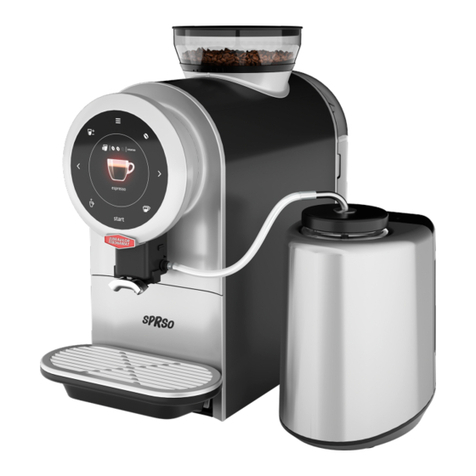
BRAVILOR BONAMAT
BRAVILOR BONAMAT SPRSO English Manual
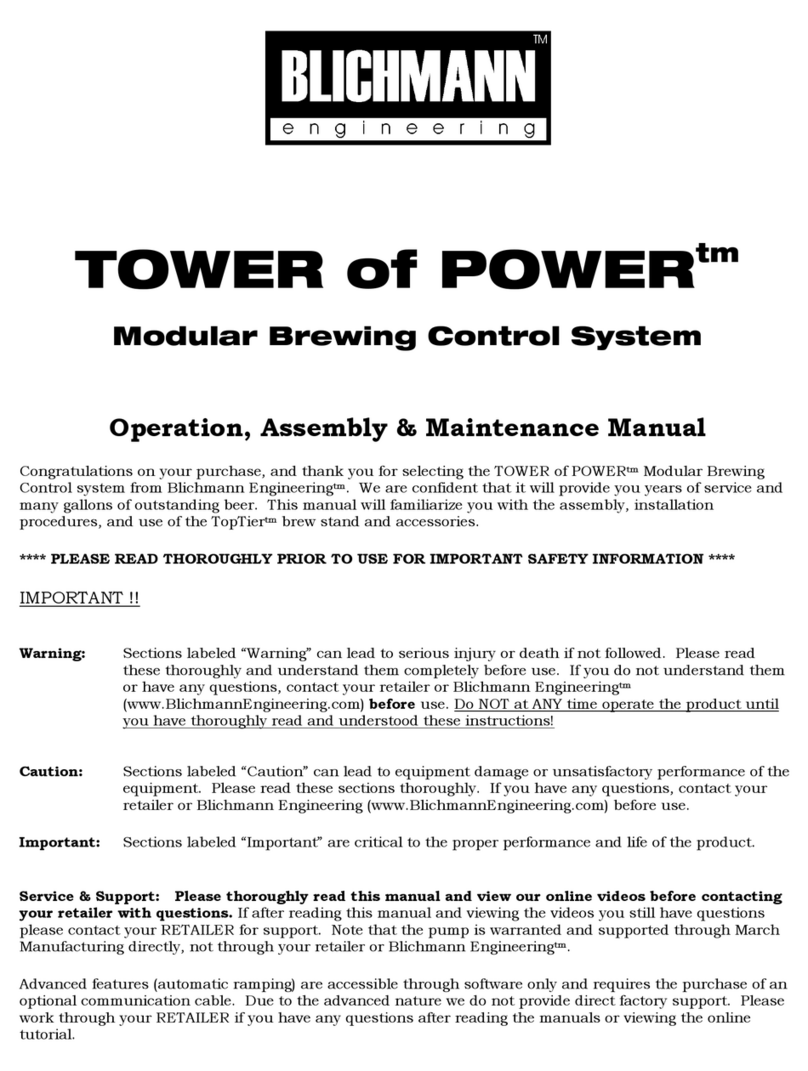
Blichmann Engineering
Blichmann Engineering TOWER of POWER Operation, Assembly & maintenance manual

Fetco
Fetco TBS-122D Users guide and operator instructions

BRAVILOR BONAMAT
BRAVILOR BONAMAT FreshMore user manual

BRAVILOR BONAMAT
BRAVILOR BONAMAT Bolero Series Technical manual
